Roman Catholic Archdiocese of Burgos
|
Archdiocese of Burgos Archidioecesis Burgensis Archidiócesis de Burgos |
|
|---|---|

|
|
| Location | |
| Country | Spain |
| Ecclesiastical province | Burgos |
| Statistics | |
| Area | 13,849 km2 (5,347 sq mi) |
| Population - Total - Catholics |
(as of 2012) 375,563 339,185 (90.3%) |
| Parishes | 1003 |
| Information | |
| Denomination | Roman Catholic |
| Sui iuris church | Latin Church |
| Rite | Roman Rite |
| Established | 1075 (As Diocese of Burgos) 22 October 1574 (As Archdiocese of Burgos) |
| Cathedral | Cathedral of St Mary in Burgos |
| Current leadership | |
| Pope | Francis |
| Metropolitan Archbishop | Fidel Herráez Vegas |
| Suffragans |
Diocese of Bilbao Diocese of Osma-Soria Diocese of Palencia Diocese of Vitoria |
| Map | |
 |
|
| Website | |
| Website of the Archdiocese | |
The Roman Catholic Archdiocese of Burgos is one of Spain's Latin Metropolitan sees.
Its ecclesiastical province includes four suffragan bishoprics:
The archdiocese comprises since the Concordat of 1851 almost the entire Burgos province. Its area is approximately 8,694 square miles (22,520 km2), with a population in the early 20th century of 340,000, divided into 1220 parishes which form forty-seven vicariates. By 2006, the number of parishes had declined to 1001.
In 2006, the Archdiocese of Burgos had 339,360 Catholics. This meant that 94% of the population was Catholic in the area. However, since the Catholic Church records people who have been baptized as members, and only with the rare occurrence of excommunication are people normally removed from the records, this figure probably includes many people who not only do not attend Catholic services but may have actually been baptized in and currently attending Protestant, Latter-day Saint or Muslim services.
The diocese had 589 Catholics per priest, which although it was higher than the 439 Catholics per priest that there had been in 1978 it was much lower than the 655 Catholics per priest in the Diocese back in 1950.
The northern and eastern portion of the diocese is mountainous, thickly wooded, and traversed by rivers, among which is the Ebro, which rises in the mountains and serves as the eastern boundary for Miranda de Ebro. The Arlanza which crosses the diocese from east to west flows by Salas de los Infantes, near the famous monastery of Santo Domingo de Silos, and through the center of the well-known town of Lerma.
The mountainous region is unproductive of cereals, but fruits grow in abundance, and fine pasture-lands sustain great herds of cows and sheep, which furnish excellent meat and milk. Delicate cheeses which take their name from the city and are famous throughout Spain, are made in this section. Minerals are abundant, especially sulphate of soda, common salt, iron, and hard coal. The southern part of the diocese, especially the valley and plains, is fertile and produces abundantly vegetables, cereals, and quite a quantity of wind. The climate, cold but healthy, is damp towards the north. Although this section has few industries, the transportation of its fruit and minerals is greatly facilitated by the numerous highways and by the railroad between Madrid and France which crosses the eastern side of the diocese from south to north. There are also some secondary railway lines for the operation of the mines.
...
Wikipedia
